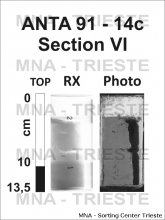Chief Scientist:
F. Giorgetti (Univ. Trieste)
Research Project:
Sedimentology and seabed sampling
Sedimentology Principal Investigator:
M. Ravaioli (CNR Bologna)
Publications:
Brambati A., 2000: Palaeoclimatic and palaeoenvironmental Records in sediments from the Southern Ocean (Strait of Magellan and Ross Sea). Terra Antarctica Reports, 4: 1-41. Brambati A., Corradi N., Finocchiaro F, Giglio F., 2002: The position of the Last Glacial Maximum grounding line in the Joides Basin: an interpretation based on sedimentological and geotechnical data. In: Gamble J.A., Skinner D.N.B., Henrys S., Lynch R. (Editors) Antarctic Earth Sciences at the Close of a Millennium. Proceedings Volume 8th International Symposium on Antarctic Earth Sciences. Royal Society of New Zealand Bulletin, 35: 365-372. Brambati A., Melis R., Quaia T., Salvi G., 2002: Late Quaternary climatic changes in the Ross Sea Area, Antarctica. In: Gamble J.A., Skinner D.N.B., Henrys, S. (eds.). Antarctica at the close of a Millennium. Proceedings Volume 8th International Symposium on Antarctic Earth Sciences, Royal Society of New Zealand Bulletin, 35: 359-364. Frignani M., Giglio F., Langone L., Ravaioli M., Mangini A., 1998: Late pleistocene-holocene sedimentary fluxes of organic carbon and biogenic silica in the nortwestern Ross Sea, Antarctica. Journal of Glaciology, 27: 697-703. Melis R, Salvi G., 2009: Late Quaternary foraminiferal assemblages from western Ross Sea (Antarctica) in relation to the main glacial and marine lithofacies. Marine Micropaleontology, 70: 39-53. 






